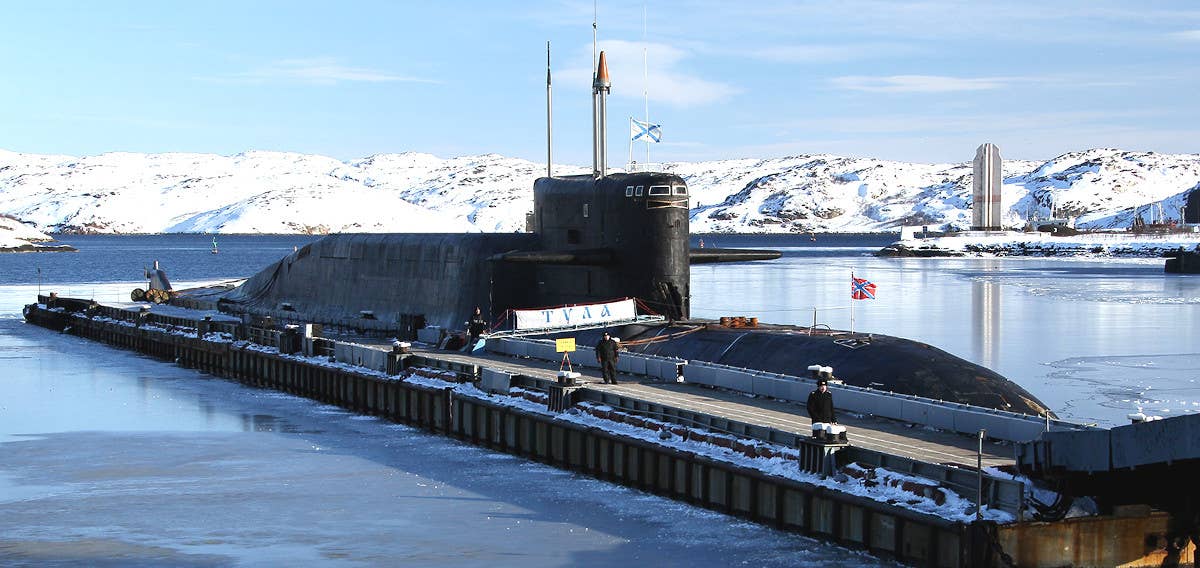Russia’s Northern Fleet submariners are set to bolster their capabilities through an extensive training program focused on mastering ice navigation in the Arctic region.
The fleet’s press service has announced plans for this strategic initiative and highlighted its pivotal role in submariners’ responsibilities in 2024. The training includes theoretical understanding and practical exercises, specifically focusing on crews of nuclear submarines.
Underscoring the critical importance of ice navigation, the press service notes that crews will undergo specialized training during the designated period.
The service added, “Special attention will be paid to improving the naval training of the crews of the strategic missile submarine cruisers of the Northern Fleet’s submarine forces.”
This targeted approach aims to fortify the readiness of these submarines for missions in the challenging Arctic environment.

As part of the winter drills, Russia’s Northern Fleet will host a training and methodological meeting at its submarine forces base. The objective is to review and consolidate best practices related to the use of nuclear submarines under Arctic ice.
The service also highlighted that in 2023, the Tula nuclear-powered ballistic missile submarine successfully conducted its first launch in a newly designated ice navigation zone within the Laptev Sea.
This affirmed the capability of the naval strategic nuclear forces to accomplish their designated missions effectively from any location within the Arctic region.
Furthermore, in October 2023, the nuclear-powered submarine cruiser Generalissimo Suvorov from the Pacific Fleet was promptly readied and navigated through the Arctic route under the ice to reach its permanent base in the far eastern naval base.
The Generalissimo Suvorov, the third vessel of the upgraded Borei-A class and the sixth among Russia’s 4th generation ballistic missile submarines has been designed to carry an arsenal of up to 16 ballistic Bulava missiles.
Commissioned on December 29, 2022, this advanced submarine stands as a significant addition to Russia’s naval capabilities.
Nonetheless, the upcoming specialized training in ice navigation is poised to consolidate Russia’s position as a formidable force in the Arctic, ensuring that its naval personnel are well-prepared to navigate the challenges presented by the region’s icy expanses.
Russian Submarines’ Maneuvers In The Arctic
The strategic importance of the Arctic is growing as the receding ice cap opens up new sea routes and unlocks valuable resources. Moscow has a presence with bases inside the Arctic Circle that surpasses NATO’s count by approximately one-third.
Russian military activities in the Arctic region have also escalated concurrently with an intensified focus on expanding infrastructure in the area.
Furthermore, Russian ballistic missile submarines have become adept at executing complex deterrent patrols under the protective shield of Arctic ice, rendering their movements difficult to track.
Moscow’s commitment to mastering Arctic naval operations is evident in its consistent execution of exercises involving submarines in the region.
A notable highlight occurred in 2021 when three Russian ballistic missile submarines successfully surfaced in unison from beneath the ice near the North Pole.
While this marked the first time such a tricky naval maneuver was achieved, it was not the first instance of submarines breaking through Arctic ice for training purposes. The US Navy conducts annual Ice Exercises (ICEX) involving submarine surfacing from beneath the ice.
That being said, the particular drill in 2021 showed the capabilities of the Russian Navy and reinforced Moscow’s efforts to maintain a formidable presence in the Arctic.
Surfacing a submarine through dense sea ice is challenging, as detailed in a 2018 article in Popular Mechanics focused on American submarines in the Arctic.
Nuclear-powered missile submarines primarily remain hidden beneath Arctic ice to maintain stealth. However, when the need arises to surface, careful planning becomes paramount.
Submarine commanders typically seek nearby patches of open water, known as “leads” or “polynyas,” to surface without encountering floating ice. When this option is not viable, a careful maneuvering process is employed to break through up to 9 feet (2.5 m) of sea ice.
The initial step involves slowly raising the submarine until its upper tower contacts the bottom of the floating ice layer.
Subsequently, compressed air is deployed to expel seawater from the submarine’s ballast tanks, which generates an upward force that cracks the ice, facilitating the emergence of the submarine.
The mastery of these challenging maneuvers reflects not only the technical prowess of the Russian Navy but also the strategic importance placed on maintaining operational readiness in the Arctic, a region of increasing geopolitical significance.
- Contact the author at ashishmichel(at)gmail.com
- Follow EurAsian Times on Google News